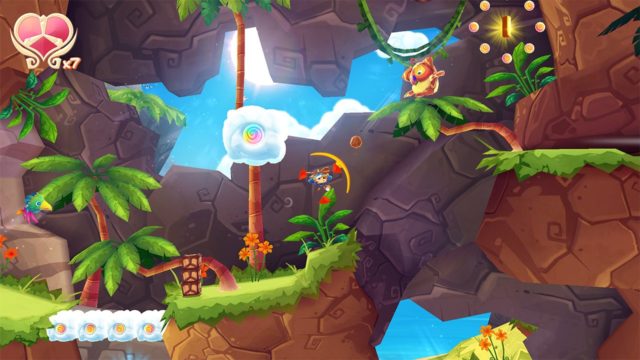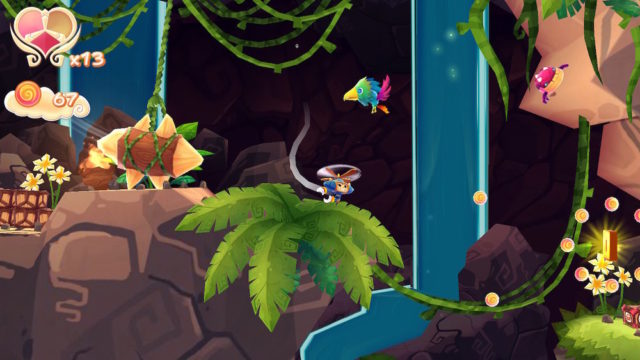The cartoony visuals and pop, especially the scrolling, multilevel backgrounds; gameplay is tight and fun; calm, placid pace of play; tons of stages
Level design becomes repetitive; light difficulty level may turn off some
I had no preconceptions about developer Picomy’s Heroki. I’d known it was a mobile release back in 2015, but beyond that, booting the game up for the first time was my true introduction to it. As it happens, I came to find I’d been missing out for the past few years on a very fun, albeit repetitive, experience. Using simple flying mechanics in lieu of traditional platforming mainstays like jumping and running, Heroki is a bubbly, colorful, and energetic title that creates a placid atmosphere that will keep players coming back for more… until they need a break once the stages start feeling too familiar.
It’s interesting to think that Heroki is a port given how naturally it fits on Switch. The game is centered on the nominal Heroki who has the capability to fly. Flight is handled very intuitively in the game with simple inputs from the control stick that send the hero in all different directions. With a tap of a button, Heroki can also rapidly plummet downwards, which allows him to burst through certain obstacles. Heroki can also throw things like crates and boulders. All of the action handles quite well with the traditional button and control sticks on the Joy-Cons/Pro Controller, although Heroki’s flight can sometimes be a tad finicky. Sometimes, he would overshoot where I wanted him to go, for instance.
Still, with enough practice, getting Heroki around is a breeze. Indeed, the gameplay itself is breezy. Though flight is the main method of transport, it really feels more akin to floating. Heroki bobs and weaves through the environment at a serene, placid pace. The difficulty does increase in Heroki, but overall this is a game that’s maybe a notch above the average Kirby title in terms of challenge; that isn’t a bad thing by any means. The joy in Heroki is in being entertained by its puzzles, light combat, and exploring the environs for different collectibles. Some might be irked that Heroki isn’t a huge test of skill, but it remains an engaging time, nonetheless.
Where Heroki fell flat for me was in the game’s somewhat repetitive level design. Stages are largely just huge mazes to fly through that are littered with goodies to find and baddies to fight, and ultimately an end goal to reach. It all flows very logically and clearly, and I definitely was having fun the bulk of the time, but eventually levels did start to bleed together. I wouldn’t pin the blame on a lack of creativity, as there are definitely spurts of it. For instance, in an early stage, a deadly bank of clouds fills the air and must be blown away. This was different from what had come in the previous levels, which is good, but the problem is that the stage itself looked identical to what preceded it.

Heroki has a lot of content to get through, with multiple stages to tackle. There’s no wanting for levels, but breaking up the visuals with some different color palettes, at least, might have been a wise design choice to make. That said, Heroki is truly lovely to look at. There’s a painterly quality to the graphics here, with flourishes of color that make all of the gameplay sing. The backgrounds are multi-tiered, as well, creating a glorious scrolling effect as Heroki flutters along the screen. All of the assets have a nice beefiness and chunkiness to them, and the enemies are all delightfully threatening, yet cartoony. Perhaps a sequel will grant Heroki the stage variety this first game would have benefited from.
One thing that helps to stave off the monotony somewhat is the central town hub. There are a variety of non-playable characters to interact with who offer Heroki different sidequests to complete. It’s nothing so engaging that it totally alleviates the lack of stage variety I discussed, but it helps. Another element of the game that keeps things lively (for a time) is the introduction of new abilities. The first power-up Heroki is granted allows him to send huge gusts of wind across the screen. This blows away visual obstructions like leaves to reveal new secrets, for instance. Which is great! Until the thousandth leaf in a row has been sent soaring. It is another unfortunate instance of Heroki introducing something to freshen up the gameplay but then not doing anything new until far too much time has passed.

All that said, Heroki is a charmer despite its flaws. There are some genuinely fun moments of puzzle-solving gameplay to revel in. The approachability of Heroki’s gameplay also works in its favor. The game feels like it’s meant to be serene and calming, offering a stolid trip through Heroki’s world for players of all skills to engage in. I’d have loved to see the injection of new ideas more frequently throughout the game, but Heroki still warrants your attention if you’re looking for an adventure game that does things somewhat different from the norm, but feels familiar enough to quickly step into and start playing.
Nintendojo was provided a copy of this game for review by a third party, though that does not affect our recommendation. For every review, Nintendojo uses a standard criteria.




 ShareThis
ShareThis





